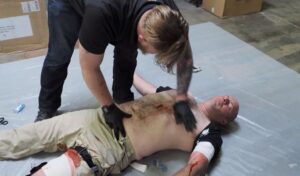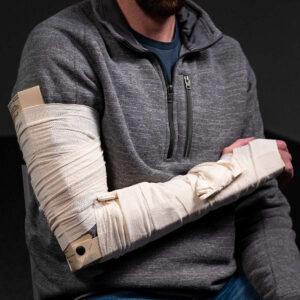Is there a Difference in Leg and Arm Tourniquets?

Yes, of course. Tourniquets (TQs) are essential tools in emergency medicine and trauma care. While both leg and arm tourniquets serve the same fundamental purpose of stopping blood flow to prevent hemorrhage, the application, and considerations for use differ significantly due to the anatomical and physiological differences between the limbs. Understanding these differences helps us to be more effective when using tourniquets in various emergencies.
Anatomical Differences
The most obvious difference between leg and arm TQ is the distinct anatomical structures of the limbs. The human arm comprises the humerus bone in the upper arm and the radius and ulna bones in the forearm, while the leg contains the femur in the thigh and the tibia and fibula in the lower leg. The thigh's femur is the largest bone in the body, surrounded by sizable muscle mass, which makes the leg larger and more robust than the arm.
Major blood vessels in the arm include the brachial artery in the upper arm and the radial and ulnar arteries in the forearm. In contrast, the leg’s major vessels are the femoral artery in the thigh and the popliteal artery behind the knee, with further branching into the anterior and posterior tibial arteries. The femoral artery, in particular, is much larger than the brachial artery, necessitating a more substantial force to compress and occlude blood flow effectively.
Tourniquet Design and Strength Requirements
Due to these anatomical differences, tourniquets like the CAT from North American Rescue, and the SOF Tourniquet from TacMed Solutions are designed to apply pressure to both arms and legs. The width of a TQ is very important because it helps distribute the pressure more evenly across the larger circumference of the thigh or bicep. This width helps to reduce pain, (although still uncomfortable!) and reduces the risk of tissue and nerve damage while effectively stopping the blood flow. These TQs have also been designed to fit arms as well, however because of the smaller size and body mass, arm TQs require less pressure to achieve bleeding control.
The material strength and mechanical design of tourniquets also need to be superior and stoutly built. Tourniquets must withstand higher tension and more substantial mechanical stress to compress the femoral and brachial artery effectively. This is why it is essential to acquire your TQs from a reputable source. Counterfeit TQs made in China and sold on Amazon do not meet the required materials construction, or quality control standards.

TacMed RISE™ Splint
Tourniquet Application Techniques
The technique of application varies between the leg and arm due to the different anatomical landmarks and muscle mass. Arm TQs are generally straightforward with fewer complications than leg TQs. Because of the small muscle mass in arms it is simple and easy to apply a TQ to an arm.
Legs are different though. Because they tend to be larger than arms in general, and because some people are built with especially big legs, it can be difficult to achieve full bleeding control. If the casualty you’re working on has large legs, and you notice that application of a TQ is not achieving bleeding control even though application is correct, this means we must place a second TQ close to the first, but just below. If no other TQ is available for this, direct pressure is the next best choice for attempting bleeding control.
It is also essential that we attempt to limit the movement of the injured arm or leg. Trauma significant enough to cause bleeding that requires a TQ means there is a good chance of a fractured bone. If these fractured bones are not stabilized, it can cause significant further damage to our casualty.
Limiting the movement of the limb when applying a leg TQ is especially hard if you don’t know the right technique. Watch the video below to see how to apply a TQ to a leg correctly.
Doc’s Wrap Up
Often, people receive basic training on how to control bleeding with a tourniquet, but don’t get much further. And that’s fair. If you aren’t confronted with this situation on a regular basis, you wouldn’t feel the need. But a basic understanding of human anatomy and physiology and what’s happening when a TQ is applied helps experienced medics and new first responders make a greater difference on scene and allows them to think outside the box and problem solve in a dangerous and dynamic situation.
If you would like to learn more about tourniquet application, wound packing, chest seals, and other items in your trauma kit, check out our FREE online course. And make sure to check out our Yellowstone and Wind River Trauma kits and be ready for whatever the Mountain throws at you.
